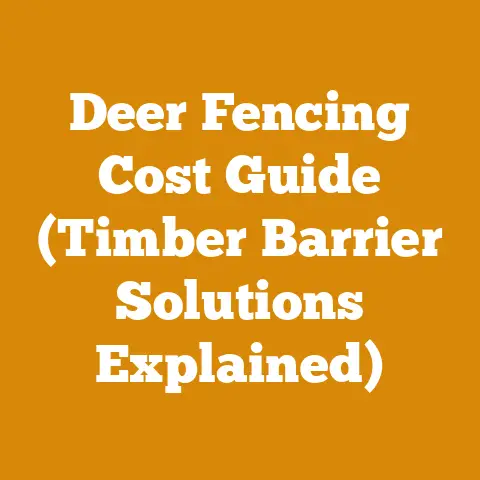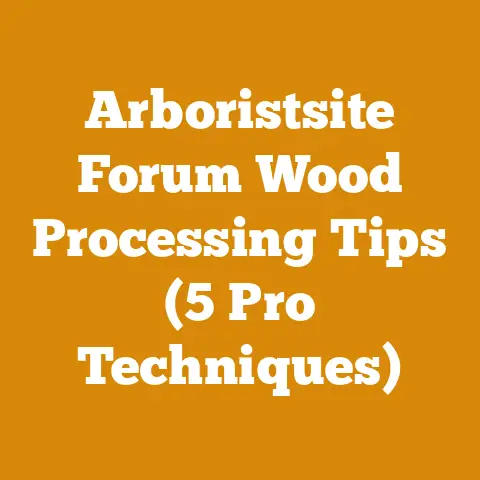Removing Bushes from Front of House (5 Expert Woodcutting Tips)
I remember the first time I was asked to clear overgrown bushes from the front of a house. It seemed simple enough, but I quickly learned that removing bushes effectively and safely requires more than just brute force. It’s a task that blends landscaping with basic woodcutting principles, and can be surprisingly challenging, especially when dealing with dense root systems and potential hazards. Over the years, I’ve developed a set of techniques that not only make the job easier but also ensure a professional-looking result.
Here are my top 5 expert woodcutting tips for removing bushes from in front of a house:
1. Planning and Preparation: The Foundation of Success
Before even touching a tool, a thorough assessment is crucial. This isn’t just about identifying the type of bushes; it’s about understanding their root systems, proximity to utilities, and potential hazards.
Assessing the Situation
- Identify the Bushes: Determine the species of bushes you’re dealing with. Some bushes have shallow, easily removable root systems, while others, like certain types of rhododendrons or junipers, have deep, extensive roots that require more effort. Knowing the species helps you anticipate the challenges.
- Locate Utilities: This is paramount! Call your local utility company (Dial 811 in the US) to mark the locations of underground cables, pipes, and wires. Hitting a gas line or electrical cable is not only dangerous but also incredibly costly.
- Check for Obstacles: Look for rocks, buried objects, or other obstructions that could damage your tools or create safety hazards.
- Consider the Environment: Are there delicate plants nearby that you need to protect? Is the ground sloped or uneven, requiring extra caution?
- Plan Your Approach: Based on your assessment, develop a plan. Decide which tools you’ll need, how you’ll dispose of the debris, and what safety precautions you’ll take.
Essential Tools and Safety Gear
Having the right tools makes a world of difference. Here’s a list of my go-to tools for bush removal:
- Gloves: Heavy-duty work gloves to protect your hands from thorns, splinters, and sharp edges.
- Safety Glasses: Essential for protecting your eyes from flying debris.
- Ear Protection: Chainsaws and other power tools can be loud; earplugs or earmuffs are a must.
- Long Pants and Sturdy Boots: Protect your legs and feet from scratches, cuts, and potential injuries. Steel-toed boots are ideal.
- Loppers: For cutting branches up to 2 inches in diameter.
- Hand Saw: A good hand saw is versatile for smaller branches and tight spaces. I prefer a pruning saw with aggressive teeth.
- Axe or Hatchet: For chopping through larger roots and stubborn branches.
- Shovel: A sturdy shovel is essential for digging around the roots.
- Pickaxe or Mattock: For breaking up hard soil and dislodging large roots. A mattock combines an axe blade and a pick for versatile digging.
- Chainsaw (Optional but Recommended for Larger Bushes): A small to medium-sized chainsaw can significantly speed up the process, especially for larger bushes with thick trunks. I typically use a 14-inch bar chainsaw for this type of work.
- Root Saw (Optional): A specialized saw designed for cutting roots underground.
- Wheelbarrow or Garden Cart: For hauling away debris.
- Tarp: To protect the ground and make cleanup easier.
- First-Aid Kit: Always have a well-stocked first-aid kit on hand in case of minor injuries.
Personal Story: The Importance of Planning
I once started removing a large juniper bush without properly assessing the root system. After hours of digging, I discovered that the main root was intertwined with a buried concrete slab. I ended up spending twice as much time and effort as I would have if I had taken the time to investigate properly beforehand. This experience taught me the invaluable lesson of thorough planning.
2. Cutting Techniques: Strategic Removal for Efficiency
The way you cut the bush can significantly impact the ease of removal. Strategic cutting breaks down the bush into manageable pieces, making it easier to handle and dispose of.
Step-by-Step Cutting Process
- Remove the Top Growth: Start by removing the branches and foliage. Use loppers or a hand saw to cut branches close to the main stem. For larger branches, a chainsaw may be necessary.
- Cut the Main Stem: Once the branches are removed, cut the main stem as close to the ground as possible. If the stem is thick, use a chainsaw. Make sure to cut at a slight angle to prevent the chain from binding.
- Expose the Root System: Use a shovel to dig around the base of the bush, exposing the root system. Be careful not to damage any underground utilities.
- Cut the Major Roots: Identify the major roots and use an axe, root saw, or chainsaw to cut them. For larger roots, you may need to use a pickaxe or mattock to break them up.
- Loosen the Root Ball: Once the major roots are cut, use a shovel and pickaxe to loosen the root ball from the soil.
- Remove the Bush: Carefully lift the bush out of the ground. If it’s too heavy to lift, use a wheelbarrow or garden cart to move it.
Chainsaw Techniques for Bush Removal
When using a chainsaw, always prioritize safety. Wear appropriate safety gear, including safety glasses, ear protection, gloves, and long pants.
- Proper Stance: Maintain a stable stance with your feet shoulder-width apart. Keep your weight balanced and avoid overreaching.
- Chain Brake: Always engage the chain brake when the chainsaw is not in use.
- Kickback: Be aware of the risk of kickback, which can occur when the tip of the chainsaw bar comes into contact with a solid object. To avoid kickback, avoid using the tip of the bar and maintain a firm grip on the chainsaw.
- Cutting Angle: Cut at a slight angle to prevent the chain from binding.
- Safe Distance: Keep a safe distance from other people and objects.
- Maintenance: Keep your chainsaw properly maintained. Sharpen the chain regularly and check the oil level before each use.
Data and Insights: Chainsaw Usage Statistics
According to the U.S. Consumer Product Safety Commission, chainsaws cause approximately 30,000 injuries each year. Most of these injuries are preventable with proper training and safety precautions. A study by the National Institute for Occupational Safety and Health (NIOSH) found that chainsaw operators who received formal training were significantly less likely to be injured than those who did not.
Case Study: Removing a Large Rhododendron
I once had to remove a massive rhododendron bush that was over 10 feet tall and wide. The root system was incredibly dense and intertwined. I started by removing the branches using loppers and a hand saw. Then, I used a chainsaw to cut the main stem as close to the ground as possible. Next, I spent several hours digging around the base of the bush, exposing the root system. I used a combination of an axe, root saw, and pickaxe to cut the major roots. Finally, I used a tractor with a chain to pull the root ball out of the ground. It was a challenging job, but with the right tools and techniques, I was able to remove the bush safely and efficiently.
3. Root Removal: Getting to the Source of the Problem
Removing the roots is essential to prevent the bush from growing back. This can be a challenging task, especially for bushes with extensive root systems.
Techniques for Root Removal
- Digging: The most common method is to dig around the roots and cut them with an axe, root saw, or chainsaw. This can be time-consuming, but it’s effective for removing most roots.
- Root Grinding: A root grinder is a specialized machine that grinds the roots into small pieces. This is a faster and more efficient method than digging, but it requires renting or purchasing a root grinder.
- Chemical Treatment: Herbicides can be used to kill the roots, but this method is not environmentally friendly and should be used as a last resort. If you choose to use herbicides, follow the manufacturer’s instructions carefully and take precautions to protect yourself and the environment.
Ensuring Complete Removal
- Follow the Roots: Trace the roots as far as possible and remove them completely. Even small pieces of root can sprout new growth.
- Fill the Hole: Once the roots are removed, fill the hole with soil and compact it. This will prevent the ground from settling and creating a depression.
- Monitor for Regrowth: Keep an eye on the area for any signs of regrowth. If you see new shoots emerging, remove them immediately.
Personal Experience: The Stubbornness of Roots
I once removed a small lilac bush, thinking I had gotten all the roots. A few weeks later, I was surprised to see new shoots sprouting up from the ground. I had to dig up the area again and remove even more roots. This experience taught me the importance of being thorough when removing roots.
4. Waste Disposal: Environmentally Responsible Practices
Proper waste disposal is crucial for protecting the environment and preventing the spread of diseases.
Options for Waste Disposal
- Composting: Branches and foliage can be composted, providing valuable nutrients for your garden. Chop the material into smaller pieces to speed up the composting process.
- Chipping: A wood chipper can be used to chip branches and foliage into mulch. Mulch can be used to suppress weeds, retain moisture, and improve soil health.
- Burning (Check Local Regulations): In some areas, it’s permissible to burn brush and branches. However, it’s essential to check local regulations and obtain any necessary permits before burning. Always burn in a safe location away from buildings and flammable materials.
- Landfill: If composting, chipping, or burning are not options, you can dispose of the debris at a landfill. Contact your local landfill for information on disposal fees and regulations.
- Curbside Pickup: Some municipalities offer curbside pickup of yard waste. Check with your local government for details.
Ethical Considerations
- Avoid Burning on Windy Days: Burning on windy days can spread embers and create a fire hazard.
- Dispose of Waste Properly: Do not dump yard waste in natural areas, as this can harm the environment and spread invasive species.
- Consider the Impact on Wildlife: Be mindful of the impact of your actions on wildlife. Avoid disturbing nesting birds or other animals.
Data and Insights: Composting Statistics
According to the Environmental Protection Agency (EPA), yard waste accounts for approximately 13% of municipal solid waste. Composting yard waste can significantly reduce the amount of waste sent to landfills. A study by the U.S. Department of Agriculture (USDA) found that compost can improve soil health, reduce the need for fertilizers, and increase crop yields.
Case Study: Sustainable Waste Disposal
I recently removed several bushes from a client’s property and wanted to dispose of the waste in an environmentally responsible manner. I chipped the branches and foliage into mulch, which I used to mulch the client’s garden beds. I composted the smaller twigs and leaves. I disposed of the larger roots at a local landfill. The client was very happy with the results and appreciated my commitment to sustainability.
5. Aftercare: Ensuring a Healthy Landscape
After removing the bushes, it’s important to take steps to ensure a healthy landscape.
Soil Preparation
- Amend the Soil: Add compost, manure, or other organic matter to the soil to improve its fertility and drainage.
- Test the Soil: Conduct a soil test to determine the pH level and nutrient content. Amend the soil as needed to create optimal growing conditions for new plants.
- Level the Ground: Level the ground and remove any rocks or debris.
Planting New Vegetation
- Choose Appropriate Plants: Select plants that are well-suited to the soil, climate, and sunlight conditions.
- Consider the Mature Size: Choose plants that will not outgrow the available space.
- Water Regularly: Water new plants regularly, especially during dry periods.
- Mulch Around Plants: Mulch around plants to suppress weeds, retain moisture, and improve soil health.
Preventing Future Problems
- Monitor for Invasive Species: Keep an eye out for invasive species and remove them promptly.
- Maintain Your Landscape: Regularly prune and fertilize your plants to keep them healthy and vigorous.
- Consider Professional Help: If you’re not comfortable performing these tasks yourself, consider hiring a professional landscaper.
Personal Story: The Joy of a New Beginning
After removing a row of overgrown yews from my own property, I was excited to create a new garden bed. I amended the soil with compost and planted a variety of flowering perennials. It was so rewarding to see the garden come to life. It reminded me that removing old bushes can create an opportunity for new beginnings.
Strategic Insights: Long-Term Landscape Planning
Removing bushes is often just the first step in a larger landscape renovation project. Consider the long-term goals for your landscape. Do you want to create a low-maintenance garden? Do you want to attract pollinators? Do you want to create a private outdoor space? By considering these questions, you can make informed decisions about what to plant and how to design your landscape.
Technical Details: Soil Amendment Specifications
When amending the soil, aim for a ratio of 1 part organic matter to 2 parts existing soil. For example, if you’re filling a hole that’s 1 cubic foot in size, use 0.33 cubic feet of compost and 0.66 cubic feet of topsoil. The ideal pH range for most plants is between 6.0 and 7.0.
Cost Estimates: Landscaping Services
The cost of landscaping services can vary widely depending on the size of the project, the type of plants, and the location. Removing bushes can cost anywhere from \$50 to \$500 per bush, depending on the size and complexity of the job. Planting new plants can cost anywhere from \$10 to \$100 per plant, depending on the type and size of the plant.
Skill Levels Required: DIY vs. Professional
Removing small bushes is a relatively simple task that most homeowners can handle themselves. However, removing large bushes with extensive root systems can be challenging and may require professional help. If you’re not comfortable using power tools or working around underground utilities, it’s best to hire a professional landscaper.
Practical Next Steps: Getting Started
- Assess the Situation: Evaluate the bushes you want to remove and identify any potential hazards.
- Gather Your Tools: Gather the necessary tools and safety gear.
- Develop a Plan: Develop a plan for removing the bushes and disposing of the waste.
- Start Cutting: Begin by removing the branches and foliage.
- Remove the Roots: Dig around the roots and cut them with an axe, root saw, or chainsaw.
- Dispose of the Waste: Dispose of the waste in an environmentally responsible manner.
- Prepare the Soil: Amend the soil and level the ground.
- Plant New Vegetation: Plant new plants and water them regularly.
- Monitor for Regrowth: Keep an eye on the area for any signs of regrowth.
- Enjoy Your New Landscape: Sit back and enjoy your newly renovated landscape.
Removing bushes from the front of a house can be a challenging but rewarding task. By following these expert woodcutting tips, you can remove bushes safely and efficiently, and create a beautiful and healthy landscape. Remember to prioritize safety, plan carefully, and dispose of waste responsibly. With a little effort and the right tools, you can transform your yard into a beautiful outdoor space.






